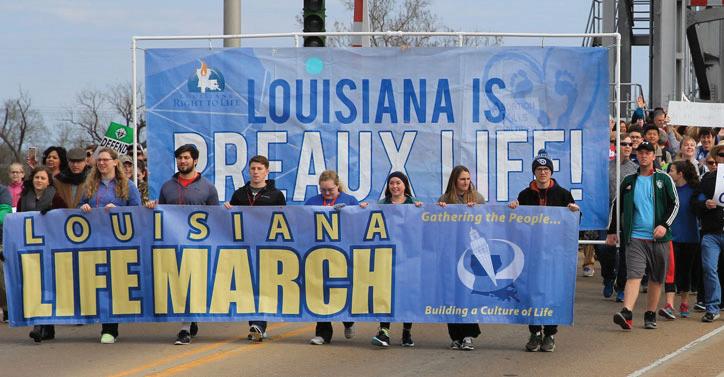
4 minute read
Fabric of the Seamless Garmet
Mark Loyet, Director of Pastoral Ministries
In 1984, President Ronald Reagan declared January 22 “National Sanctity of Human Life Day.” That year, January 22 was the 11th anniversary of Roe v. Wade (the infamous US Supreme Court case which legalized abortion nationwide). Every year since 1984, pro-life presidents have re-proclaimed January 22nd or the Sunday closest to it as the same designation and prolife advocates have demonstrated and made their voices heard in various ways. As we approach this year’s National Sanctity of Human Life Day, I would like to address an issue that is a common topic of debate among Catholics of all stripes. That is whether or not there is a “pre-eminent” prolife issue. Spoiler alert! The Church’s answer is a resounding yes!
Advertisement
Opponents of this answer (Note: I am not asserting opponents of this answer are opponents of the pro-life cause) usually cite what is known as the “Consistent Ethic of Life Theory” or the “Seamless Garment Theory” which posits that all human life, from conception to natural death is sacred and that any form of threat against the inherent dignity of human life (e.g. abortion, euthanasia, assisted suicide, unjust war, slavery, racial prejudice and many more) must be opposed. This is indeed Catholic teaching.
However, it is important to note what the authentic and Catholic version of this teaching is saying, and what it is not saying. What it is saying is that all human life is sacred no matter what the circumstances, that all issues concerning the sanctity of human life are fundamentally intertwined, and that any and all threats to the sanctity of human life are unjust, immoral, and must be opposed. What this teaching is not saying is that all threats to human life and dignity are equal. This latter point is where many people start to get uncomfortable and some outright disagree. For example, there are those who would actually make the argument that an employer paying their employees an unjustly low wage is as equal a violation of the dignity of human life as euthanasia. Or, selfishly refusing to give a homeless person a meal is equal to performing an abortion. Would these same people argue that a car wreck is as much a disaster as a 9.0 earthquake in New York city?
The reality of this interpretation of the Seamless Garment theory is that it is neither an accurate portrayal of the theory, nor in conformity with Catholic moral teaching. The term “Seamless garment” was coined by Eileen Eagan in 1971 in a pamphlet entitled The Unborn Child and the Protection of Human Life, in which she argued the need for consistency in our defense of human life using the image of Jesus’ prized seamless garment. She rightly pointed out that, especially at that time, many people failed to see the pro-life issue as extending beyond the evil of abortion. The phrase was later popularized by Cardinal Joseph Bernardin of Chicago who also argued that to be pro-life is to be concerned for and actively opposed to all threats against human life. He said, “When human life is considered ‘cheap’ or easily expendable in one area, eventually nothing is held as sacred and all lives are in jeopardy.” This was not a novel teaching but was a reemphasizing of Catholic doctrine which had been neglected by many who called themselves “pro-life” but held views contrary to Church teaching on issues such as war, treatment of the needy, etc. All of this was perfectly accurate and much needed.
A new interpretation of this theory has become somewhat popular which proposes that not only should all threats against human life be opposed (true), but that they are all equal in gravity (false). It is worth noting that Eileen Eagan and Cardinal Bernardin did not teach this, nor does the Magisterium of the Church. The Church has consistently taught, and very recently reaffirmed that “The threat of abortion remains our preeminent priority because it directly attacks life itself.” This exact teaching has been reaffirmed by Pope Francis and the US Bishops as recently as 2020. If you struggle with this teaching, ask yourself these questions: Do I believe that some evils are fundamentally worse than others? Do I not live that way? Do I not experience a much greater amount of horror when I hear of a school shooting than a bank robbery? The fact is I have never met a person who actually lives as though all moral evils are equal. To do so simply goes against our nature and revelation from God. Scripture is full of examples of how some acts are worse and therefore offend God more than others. To be pro-life is to respect human life in all circumstances, however, abortion is a preeminent issue on which the Church focuses because it is a direct threat to the dignity and sanctity of human life itself. We can still promote a “Consistent Ethic of Life,” and also remember the right to life itself is the fabric of that garment which is woven when “God knits us in our mother’s womb.” (Psalm 139:13, NAB)
Baratte, Linda L., “Religious Education in the Prophetic Voice: The Pedagogy of Eileen
Egan,” Religious Education, http://old. religiouseducation.net/member/03_papers/
Baratte.pdf Overberg, Kenneth R. S.J.:”A Consistent Ethic of Life”, Catholic Update, St. Anthony’s Press,
2009 United States Conference of Catholic Bishops, Forming Consciences for Faithful Citizenship, (Washington, DC: United States Conference of Catholic Bishops, 2020), No. 22.









